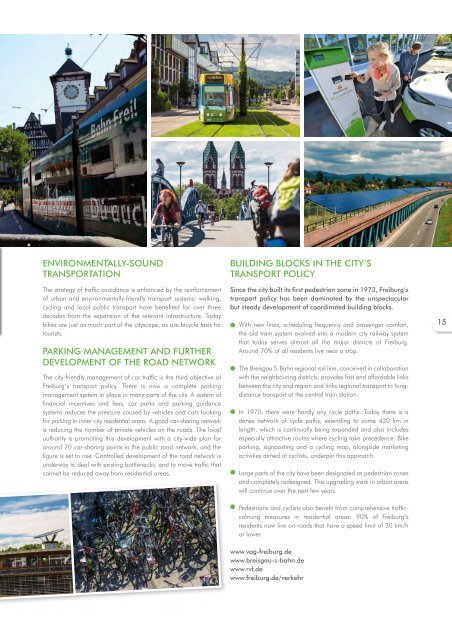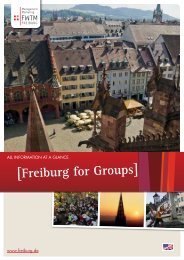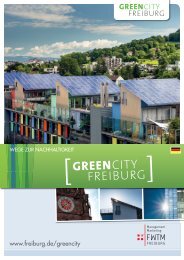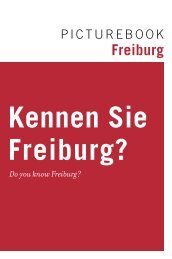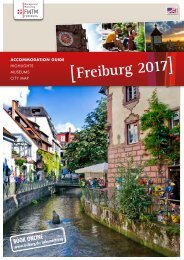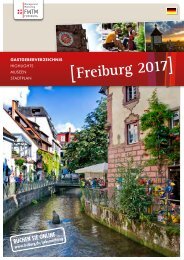13_Freiburg_Green_City_Brochure_English
Create successful ePaper yourself
Turn your PDF publications into a flip-book with our unique Google optimized e-Paper software.
ENVIRONMENTALLY-SOUND<br />
TRANSPORTATION<br />
The strategy of traffi c avoidance is enhanced by the reinforcement<br />
of urban and environmentally-friendly transport systems: walking,<br />
cycling and local public transport have benefi ted for over three<br />
decades from the expansion of the relevant infrastructure. Today<br />
bikes are just as much part of the cityscape, as are bicycle taxis for<br />
tourists.<br />
PARKING MANAGEMENT AND FURTHER<br />
DEVELOPMENT OF THE ROAD NETWORK<br />
The city-friendly management of car traffi c is the third objective of<br />
<strong>Freiburg</strong>‘s transport policy. There is now a complete parking<br />
management system in place in many parts of the city. A system of<br />
fi nancial incentives and fees, car parks and parking guidance<br />
systems reduces the pressure caused by vehicles and cars looking<br />
for parking in inner-city residential areas. A good car-sharing network<br />
is reducing the number of private vehicles on the roads. The local<br />
authority is promoting this development with a city-wide plan for<br />
around 70 car-sharing points in the public road network, and the<br />
fi gure is set to rise. Controlled development of the road network is<br />
underway to deal with existing bottlenecks, and to move traffi c that<br />
cannot be reduced away from residential areas.<br />
BUILDING BLOCKS IN THE CITY‘S<br />
TRANSPORT POLICY<br />
Since the city built its first pedestrian zone in 1973, <strong>Freiburg</strong>‘s<br />
transport policy has been dominated by the unspectacular<br />
but steady development of coordinated building blocks.<br />
●<br />
●<br />
●<br />
●<br />
●<br />
With new lines, scheduling frequency and passenger comfort,<br />
the old tram system evolved into a modern city railway system<br />
that today serves almost all the major districts of <strong>Freiburg</strong>.<br />
Around 70% of all residents live near a stop.<br />
The Breisgau S-Bahn regional rail line, conceived in collaboration<br />
with the neighbouring districts, provides fast and affordable links<br />
between the city and region and links regional transport to longdistance<br />
transport at the central train station.<br />
In 1970, there were hardly any cycle paths. Today there is a<br />
dense network of cycle paths, extending to some 420 km in<br />
length, which is continually being expanded and also includes<br />
especially attractive routes where cycling take precedence. Bike<br />
parking, signposting and a cycling map, alongside marketing<br />
activities aimed at cyclists, underpin this approach.<br />
Large parts of the city have been designated as pedestrian zones<br />
and completely redesigned. This upgrading work in urban areas<br />
will continue over the next few years.<br />
Pedestrians and cyclists also benefi t from comprehensive traffi c-<br />
calming measures in residential areas: 90% of <strong>Freiburg</strong>‘s<br />
residents now live on roads that have a speed limit of 30 km/h<br />
or lower.<br />
15<br />
www.vag-freiburg.de<br />
www.breisgau-s-bahn.de<br />
www.rvf.de<br />
www.freiburg.de/verkehr


